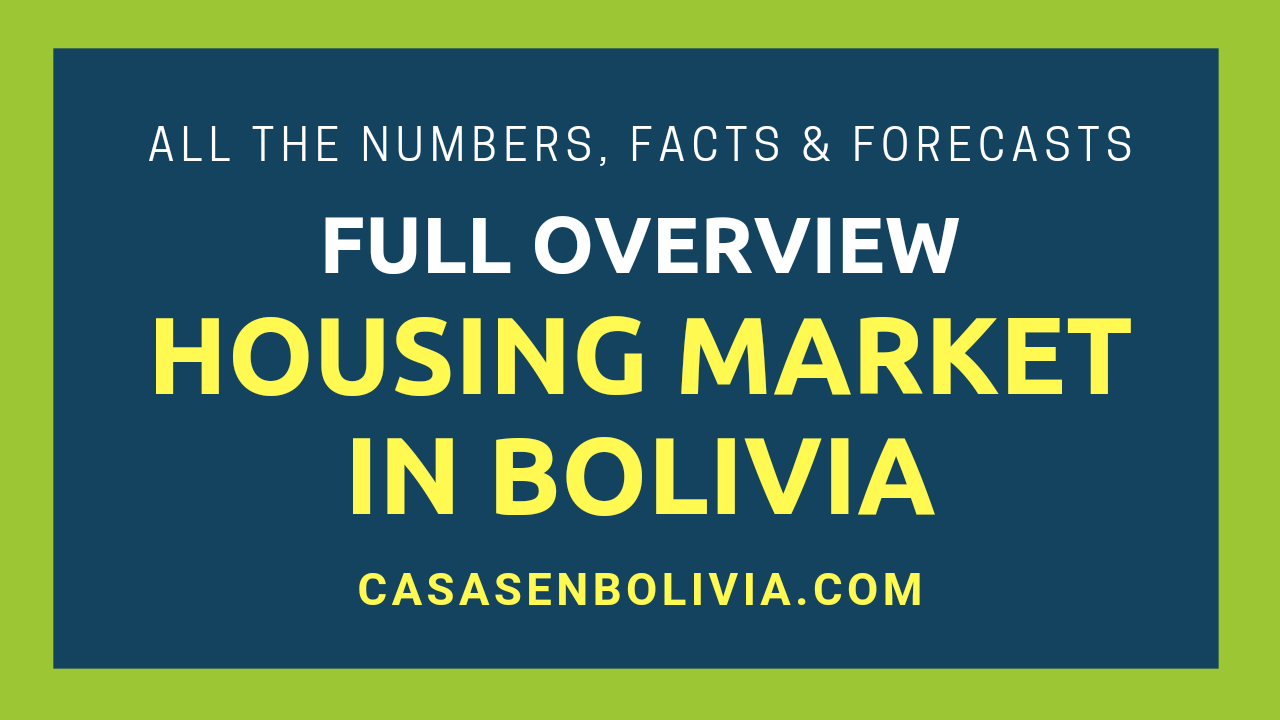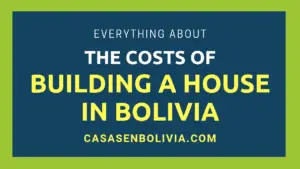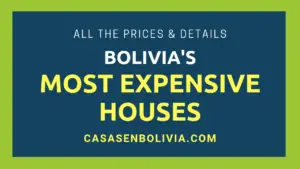Last Updated on February 15, 2025
The Bolivian real estate market is small but steadily growing, and it hasn’t experienced significant volatility throughout its history. This market has seen consistently rising prices at a slow but stable rate. However, the pandemic brought about some lasting changes in 2020.
The housing market in Bolivia grew steadily and continuously over the past decade, but experienced a 10% drop in sale prices and a 30% drop in rental prices in 2020. By 2022, housing prices have rebounded to pre-pandemic levels, and solid, continuous growth is anticipated through 2025.
In the following sections, you’ll find detailed information about the current state of the Bolivian real estate market and our projections, as Bolivian real estate experts, for its future evolution. You’ll also learn about some real estate investment strategies that are currently performing well in the country.
What is the Housing Market in Bolivia?
The housing market in Bolivia is the arena where home sellers and buyers come together to conduct transactions involving the sale, rental, signing of “anticreticos” (a form of mortgage), or exchanges of these properties.
The number of sellers, as well as the number of buyers, among other microeconomic and macroeconomic variables, determine the selling prices of real estate properties in the Bolivian housing market, similar to any other country worldwide.
We’ll now examine the current state of the Bolivian real estate market based on our analysis and perspective (you can visit our Spanish real estate website), incorporating our economic, financial, market, and demographic knowledge of the real estate sector in our country.
General Situation of the Housing Market in Bolivia
Currently, in 2022, Bolivia is in a phase of recovery, with prices returning to their late-2019 levels, before the pandemic. At that time, property prices had been steadily increasing throughout the entire 2010s decade. However, the pandemic triggered a significant shock, impacting both property sale prices and rental rates.
Here’s a summary of what occurred with real estate and home sale prices in the Bolivian housing market:
- They experienced steady growth from the beginning of the 2010s until the end of 2019.
- They decreased by approximately 10% during 2020.
- They recovered by around 5% during 2021.
- It’s anticipated that they will reach pre-pandemic levels during 2022.
- It’s expected that from 2023 to 2025, they will grow at a similar pace to that of the 2010s decade.
Additionally, here’s what happened to rental prices in the Bolivian housing market:
- They also experienced steady and continuous growth during the 2010s, until the end of 2019.
- They dropped by approximately 30% in 2020.
- They recovered and reached levels around 10% lower than in 2019.
- It’s expected that home rental prices will reach pre-pandemic levels in 2022, and from that point forward, they will grow at the same pace as before the pandemic.
- It’s expected that office and corporate rental prices will reach 2019 levels during 2023, followed by slower growth (this is a consequence of the shift from work done in physical spaces to virtual ones, which has also occurred in Bolivia).
In short, here’s a timeline of what has happened, is happening, and is projected to happen in the Bolivian real estate market:
- The 2010-2019 decade was a period of stable growth.
- 2020 was a year of recession in the housing market.
- 2021 was a year of recovery.
- 2022 is a year of stabilization.
- From 2023 to 2025, another period of stable growth is expected, with prices similar to those of 2019 as a starting point.
1) The Past 10 Years
Over the past 10 years, the Bolivian housing market has experienced stable and continuous growth in property prices, primarily driven by three factors:
- The accelerated and continuous demographic growth of Bolivia’s population. The larger the population of a country or region, the more valuable its properties become.
- Bolivia’s GDP grew at a rate of 4% per year during the 2010s decade. The wealthier the people of a country are, the higher the price they can afford for real estate properties.
- Immigration to the most populated areas and cities in Bolivia from all over the country has been continuous and very rapid. The more people migrate to a city or region, the more valuable the properties in that location become.
During the past decade (2010), these three variables have consistently driven prices higher in the Bolivian housing market, mitigating and even neutralizing the impact of speculation and unexpected events that could have created market bubbles or triggered volatility in property prices.
This is why home prices, in a steady manner and with significant acceleration at the beginning of the 2010s decade, increased from around $40/sq ft to nearly $110/sq ft in 2019 in most commercial and residential neighborhoods of Bolivia.
However, all of this changed due to an unforeseen and fortuitous event with overwhelming force: the pandemic.
The 2010s decade was a period of continuous and steady growth in both sale and rental home prices in Bolivia, with prices multiplying by 250% throughout this decade.
2) During the Pandemic
At the beginning of 2020, the effects of the COVID-19 pandemic became evident in Bolivia. Quarantine measures were implemented, and people became, in many ways, very anxious and fearful. They attempted to avoid or postpone most real estate transactions. They also suddenly had less money to pay rent and began selling their properties to gain liquidity and cover unexpected medical expenses and similar costs.
As a result, during 2020, home sale prices decreased by approximately 10%, reaching around $100/sq ft in the most exclusive neighborhoods of the country. The impact was greater on rental prices, which fell by about 30% that year compared to the prices prevalent at the end of 2019.
During 2021, properties *began to regain their previous values*. In many cases, home selling prices managed to reach pre-pandemic levels, though not in all neighborhoods and cities, nor for all types of real estate properties. However, rental prices remained lower, still 15% to 20% below pre-pandemic levels.
It was also observed that *trends toward virtual and remote work accelerated by five years in Bolivia*. This shift in working styles, which is also occurring globally, is causing spaces intended for offices, businesses, and similar workplaces *to permanently lose “growth momentum” in their rental prices*.
Now, in 2022, real estate for housing has nearly reached the price levels that existed at the end of 2019, and it’s anticipated that, during this year, prices will stabilize at those levels. However, prices for office and business spaces are still lagging, and it’s expected that they will only reach pre-pandemic levels in 2023. From that year forward, their price growth rate is projected to be slower than in the 2010s decade.
2020 was a year of economic recession as a result of the pandemic, causing a general 10% decline in real estate selling prices and a 30% drop in rental prices.
3) The Next Two Years
As we’re already observing, 2022 is expected to be a year of stabilization for housing prices, returning to the levels seen at the end of 2019. Prices are expected to recover to very similar levels in almost all zones and cities of Bolivia, except for rental prices of offices and corporate spaces, which are projected to reach pre-pandemic levels only in 2023.
During 2023, growth that might have occurred in 2020 is expected to begin, potentially even accelerating slightly this year. This could be caused by a “recovery rebound effect” following the practical end of the pandemic’s economic impacts. However, this remains highly uncertain, and this rebound effect might not materialize.
At the very least, it’s anticipated that during these next two years, real estate prices will remain *equal to or above* the levels they reached at the end of 2019. This means prices will be around $110/sq ft for home sales in Bolivia’s most exclusive neighborhoods and areas.
Both 2022 and 2023 will be years of stabilization for sale and rental prices in the housing market, and likely with growth exceeding 2019 levels in 2023.
4) The Next Five Years
In general, from mid-2023 onward, home sale prices are expected to continue growing at least at the same rate as they did during the 2010s decade. A rebound effect in housing prices might also occur during 2023, potentially causing prices that year and part of 2024 to grow even faster than anticipated.
This would happen if the Bolivian economy experiences a similar general rebound effect, and after the pandemic’s effects completely subside, it attempts to reach growth levels as if this health emergency hadn’t occurred, triggering a growth peak of more than 5% of GDP during 2023. If this rebound effect doesn’t materialize, *at a minimum, growth at the same pace as in the 2010s* will occur from 2023 to 2025.
Growth rates for housing prices will certainly recover, except for properties intended for offices in downtown areas of Bolivia’s major cities. It’s predicted that this type of real estate space, initially in its rental prices and later in its sale prices, will no longer grow at the same rate as during the 2010s decade. This is a consequence of the changes in work patterns, also occurring in Bolivia, with the advent of improved virtual working environments, 5G technology, and virtuality as a permanent phenomenon.
Beyond 2025 and up to 2028, it’s difficult to make detailed predictions. However, nothing suggests that property values in the country will decline or remain at their current prices. They will simply increase in price, at least at the same rate as in the 2010s decade. Only catastrophic events, such as a deep recession in Bolivia similar to Venezuela’s, or significant global issues, could alter this trend.
There’s no indication that a more accelerated increase in residential housing prices will occur, perhaps driven by changes in work patterns from physical to virtual. *Instead, a redistribution of where people live is likely to take place*. The remote workforce will prefer more residential and premium neighborhoods over standard ones to support their virtual work. These neighborhoods will offer larger, more comfortable spaces and environments designed to support virtual and remote work.
These neighborhoods and properties with these features of *comfort and ergonomics for remote work* “might” see both their sale and rental prices increase, and also a higher rate of growth in these prices compared to neighborhoods that don’t offer these types of amenities and features. However, this remains quite uncertain, and it remains to be seen if it will actually happen.
From 2023 to 2025, and very likely until 2028, the growth rate of prices for real estate properties will once again be very steady and continuous, as we observed in the 2010s decade, except for properties designed for corporate spaces and offices.
Variables that Influence the Real Estate Market in Bolivia
The most important factor to determine in any real estate market is the selling price of its properties, both in the present and in the future.
To achieve this, we need to consider the five most important components of the housing market in Bolivia:
- Sellers. Individuals who list their properties for sale. For example, if there are numerous sellers, there’s a large supply of properties, and *prices decrease*.
- Buyers. Individuals who want to purchase a property. For example, if there are numerous buyers, there’s high demand for real estate spaces, and *prices increase*.
- Sale Price. This is the most important variable, where the other variables converge and produce their effects. Ultimately, we want to know the value of a property and *forecast its future cost*.
- Intermediaries. These include banks and realtors, with the former offering financing for real estate acquisition and the latter providing selling services. For example, if mortgage interest rates decrease, more people will be inclined to buy properties with home loans, and *prices increase*.
- Regulators. These are government entities that regulate and establish norms for the housing market. For example, if there’s effective regulation, people have less fear of being scammed or misled, leading to increased demand for properties and *higher real estate prices*.
These variables largely determine property prices in any real estate market, but the following variables also have a significant influence:
- The country’s GDP growth. This is one of the most important variables affecting real estate market prices. For example, if people have more money, they can offer more cash to purchase a property, and *prices increase*.
- Migration patterns. Another crucial variable affecting the housing market. For instance, if people migrate to the outskirts of cities like Santa Cruz in Bolivia on a large scale, as we’re currently observing, *the prices of these properties on the city’s outskirts increase*.
- Speculation and unexpected events. Completely unforeseen events and the speculation caused by emotions and uncertainty can lead to price changes in real estate markets and their properties. For example, due to the pandemic, which stalled the country’s economy and put people in crisis, there was a need for greater liquidity and reduced demand for property purchases, resulting in *decreased prices*.
- Information asymmetry. Each real estate property is unique, and people generally don’t know how to accurately determine a home’s price. Those with more knowledge take advantage of those with less knowledge about a property. For instance, if a buyer knows that renovating a property could increase its price by about 20%, they can offer 10% more to purchase it and still realize a 10% profit when they sell the house, leading to *increased prices*.
- Leverage. This refers to increasing the reach of investment through loans. For example, if banks offer loans at very low interest rates over extended periods and have few requirements, more people are encouraged to buy properties with mortgages, leading to *increased prices*.
- Added value. The potential to materialize added value to a property after purchasing it. In many cases, this isn’t reflected in the initial purchase price but is reflected in the higher price at which it’s later sold. This property has gained added value through renovations, additional construction, extensions, and similar activities, *leading to increased prices*.
Real Estate Opportunities Currently Exist in Bolivia
Based on the factors outlined above, we believe that, currently and likely throughout the 2020s, opportunities for purchasing real estate properties with a good return on investment in Bolivia will be found in:
- Purchasing land and small houses on the outskirts of cities like Santa Cruz and El Alto (which, incidentally, are experiencing very high population growth), and to a lesser extent, cities like Trinidad and Cobija (*for foreigners, we recommend only Santa Cruz*, and with much greater caution, El Alto).
- Purchasing one-bedroom and small apartments, with an area of 400 sq ft to 600 sq ft, in premium and very exclusive neighborhoods—meaning the best neighborhoods in Bolivia [link]—such as Equipetrol, Calacoto, or Cala Cala, to capitalize on the high earnings these properties generate when rented.
- Purchasing and renting properties that facilitate remote and virtual work, with features and amenities that support this working style, such as having more space for rooms and specific areas for studying and working, separate spaces for children, and also in more residential neighborhoods, among other aspects.
- Purchasing high-quality and even luxury real estate properties for Airbnb, as this is a growing trend in Bolivia for short-term rentals for tourists and similar individuals, primarily in very residential neighborhoods like Equipetrol, Calacoto, or Cala Cala, and in the downtown areas of major cities. *However, this situation likely won’t persist indefinitely*, and the high earnings with Airbnb in Bolivia will probably stabilize and normalize around 2025.
As you can see, during the 2020s, purchasing a real estate property in Bolivia will, in almost all cases, be a sound investment. It will help preserve wealth and act as a store of value (and generate at least the same earnings as you could obtain in Bolivian savings accounts, and with almost the same returns as in stock markets of developed countries). It’s a fact that real estate in Bolivia almost always appreciates in value, and this trend is not expected to change during this decade, and likely not during the next decade in 2030.
If you’d like to learn more about how to buy a house in Bolivia, including all the necessary steps, as well as all the necessary precautions and restrictions you face in the country, please visit our in-depth guide on this topic here: How to buy a house in Bolivia? A complete guide.
Conclusions:
In this overview of the Bolivian real estate market, you’ve learned how this market operates and that it experienced steady and continuous growth throughout the 2010s decade. This growth was driven by constant migration to the country’s most populated areas, rapid GDP growth, and a permanently high birth rate.
You’ve also learned that during the pandemic, an economic recession began, causing home sale prices to drop by around 10% and rental prices by around 30%. Additionally, 2021 was a year of recovery, and 2022 is a year of stabilization. Furthermore, from 2023 to 2025, or even beyond, we anticipate a similar growth rate in home prices to that of the 2010s decade, remaining very steady and solid, except for real estate properties intended for corporate spaces and offices.
You’ve also seen that currently, there are some significant opportunities for investment in the Bolivian housing market, such as properties on the outskirts of major cities experiencing rapid population growth (like Santa Cruz or El Alto), small apartments in Bolivia’s best neighborhoods, investing in the Airbnb trend, and investing in properties that facilitate remote and virtual work.
We hope this information has been helpful. If you’d like to learn more accurate technical details about the current state of the real estate industry in Bolivia, including figures on rental property earnings, home prices, and the potential return on investment, please visit our dedicated article here: The real estate field in Bolivia: A complete overview.
CasasenBolivia.com, information on living, working, investing, and traveling in Bolivia.








